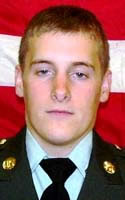Decoteau, Marc P.
Army Specialist

Marc P. Decoteau, age 19, from Waterville Valley, New Hampshire, Grafton county.
Parents: Mark Decoteau and Nancy Decoteau
Spouse: None
Children: None
Service era: Afghanistan
Schools: Plymouth Regional High (2008)
Military history: 6th Psychological Operation Battalion (Airborne), 4th Psychological Operations Group (Airborne), Fort Bragg, North Carolina. Enlisted in 2008.
Date of death: Friday, January 29, 2010
Death details: Died in Wardak Province, Afghanistan of injuries sustained Died in Wardak Province, Afghanistan of injuries sustained when an Afghan interpreter shot him and also killed David J. Thompson of Oklahoma. The interpreter was arguing about his quality of work.
Cemetery: Waterville Valley
Source: Department of Defense, Foster Daily Democrat, New Hampshire Union Leader, Concord Monitor, The Citizen of Laconia; The Pilot of Southern Pines, North Carolina., Military Times
